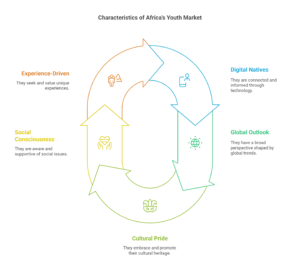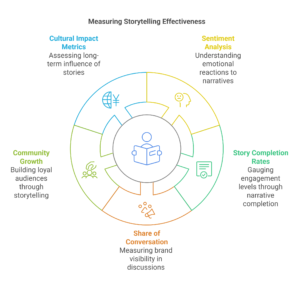In a rapidly evolving market, capturing the attention and loyalty of younger audiences has never been more critical for business success. For African brands, storytelling has emerged as a transformative tool to create deep and meaningful connections with this vibrant demographic. With a staggering 60% of Africa’s population under 25, brands must ditch outdated advertising strategies and embrace authentic engagement.
Today’s youth are digital natives—globally connected, socially conscious, and deeply proud of their cultural roots. To resonate with them, brands must weave captivating narratives that celebrate African identity and values.
In this article, we’ll delve into how African businesses can harness the power of storytelling to not only engage younger audiences but also cultivate unwavering brand loyalty and pave the way for sustainable growth. Get ready to discover new strategies that will elevate your brand and make a lasting impact!
Understanding Africa’s Youth Market
Africa’s young consumers are diverse, spanning multiple cultures, languages, and economic backgrounds. However, they share common traits that influence their purchasing behaviour:
- Digital Natives – Most have grown up with smartphones and access to social media.
- Global Outlook – Exposure to international trends influences their preferences and expectations.
- Cultural Pride – They value African traditions and seek brands representing their identity.
- Social Consciousness – They support brands that stand for causes they believe in.
- Experience-Driven – They prioritise meaningful experiences over material possessions.

Key Strategies for Crafting Authentic Brand Stories
-
Root Your Story in African Culture
Young consumers desire brands that reflect their identity, and companies that incorporate African traditions, folklore, and symbolism into their storytelling can create strong emotional connections. A prime example is the South African fashion brand MaXhosa Africa, founded by Laduma Ngxokolo in 2010. MaXhosa Africa modernizes traditional Xhosa beadwork patterns, symbolism, and colours in its knitwear designs, blending heritage with contemporary style. This approach not only celebrates Xhosa culture but also resonates with fashion markets worldwide.
The brand’s success demonstrates the power of culturally infused storytelling in building meaningful connections with younger audiences.
Strategy:
- Highlight cultural craftsmanship, language, and storytelling traditions.
- Showcase the meaning behind African symbols, patterns, and proverbs.
- Use real-life community stories to emphasize cultural pride.
-
Prioritize Visual and Digital Storytelling
Gen Z and Millennials exhibit a strong preference for visual content, such as images and videos, over text-heavy messaging. This inclination is evident in their engagement with platforms like TikTok and Instagram, which prioritize short-form video content. Incorporating visually compelling content that mirrors the interests and identities of Gen Z and Millennials can significantly enhance a brand’s connection with these audiences.
Strategy:
- Use short-form videos (TikTok, Instagram Reels, YouTube Shorts) for brand storytelling.
- Create visually engaging content that blends tradition with modern aesthetics.
- Leverage memes and GIFs to make content relatable and shareable.
-
Engage Audiences Through Social Media & Interactive Content
Younger consumers in Africa expect brands to actively engage in their digital environments, as engagement-driven content fosters community and loyalty.
Research indicates that African youth are the most connected demographic online, with 34% of young people in sub-Saharan Africa using the internet, compared to 25% of the general population. This connectivity enables them to engage with brands and participate in digital communities actively.
Strategy:
- Use polls, quizzes, and challenges to spark interaction.
- Create augmented reality (AR) filters that allow users to engage with your brand.
- Host live Q&A sessions with brand ambassadors and influencers.
-
Collaborate with Influencers and Storytellers
As influencer marketing continues its meteoric rise—projected to reach USD 107.72 billion by 2030—African brands have a unique opportunity to leverage digital influence for deeper audience engagement. With a rapidly growing social media user base and rich cultural diversity, collaborating with influencers and digital storytellers can amplify brand narratives, enhance authenticity, and drive meaningful connections with younger consumers. By partnering with creators who share their values and lifestyles, brands can tap into the power of relatable storytelling, fostering trust and long-term loyalty in an increasingly digital world.
Strategy:
- Partner with micro-influencers who have engaged and loyal followings.
- Work with digital creators to produce authentic, narrative-driven content.
- Use influencer testimonials to reinforce brand credibility.
-
Encourage User-Generated Content (UGC)
User-generated content (UGC) enables customers to actively participate in a brand’s narrative, fostering a sense of community and authenticity. A notable example is Coca-Cola’s “Share a Coke” campaign, which replaced the traditional Coca-Cola logo with popular names on bottles and cans. This personalization encouraged consumers to find bottles with their names or those of friends and family, leading to the widespread sharing of photos on social media platforms. The campaign, which began in Australia in 2011, expanded globally, including various African countries. In Kenya, for instance, the campaign allowed people to replace the Coca-Cola script with their names, generating significant buzz and engagement.
The success of the “Share a Coke” campaign underscores the effectiveness of UGC in enhancing brand engagement. By inviting consumers to personalize their Coke bottles and share their experiences online, Coca-Cola tapped into the desire for personal connection and social sharing, resulting in increased brand visibility and consumer interaction.
Incorporating UGC into marketing strategies allows brands to build stronger relationships with their audience, as consumers are more likely to trust and engage with content created by their peers. This approach not only enhances authenticity but also encourages a community-driven brand experience.
Strategy:
- Launch UGC campaigns that invite customers to share their experiences.
- Feature customer stories on social media and in marketing materials.
- Reward users with incentives for participating in brand storytelling.
Measuring Storytelling Effectiveness

Effective storytelling isn’t just about crafting compelling narratives—it’s about driving tangible business growth. To ensure your brand’s storytelling resonates with younger audiences and delivers real impact, it’s crucial to track key performance metrics. Here’s how brands can measure storytelling effectiveness:
Sentiment Analysis – Understanding Emotional Reactions
Tracking how audiences feel about your brand’s story is essential. Sentiment analysis tools use AI to analyze social media comments, reviews, and discussions to determine whether the response is positive, neutral, or negative. A brand with a compelling narrative should see increased positive sentiment, demonstrating deeper emotional engagement.
Story Completion Rates – Gauging Engagement Levels
For video and interactive content, completion rates indicate whether audiences stay engaged until the end. High drop-off rates suggest a need for stronger storytelling techniques, while high completion rates indicate the content is holding attention.
Share of Conversation – Measuring Brand Visibility
This metric assesses how much your brand’s story is discussed online compared to competitors. Tools like Google Trends, social listening platforms, and hashtag analytics can help track whether your brand narrative is shaping industry conversations.
Community Growth – Building Loyal Audiences
Strong storytelling should drive the expansion of brand communities across social media and online forums. Metrics such as follower growth, engagement rate, and active discussions in brand-led groups provide insight into the impact of your narrative.
Cultural Impact Metrics – Assessing Long-Term Influence
Beyond immediate engagement, brands should evaluate how their storytelling influences societal perceptions and consumer behavior over time. Surveys, brand recognition studies, and media coverage can help measure this impact.
By monitoring these metrics, African brands can refine their storytelling strategies to maximize engagement, build brand loyalty, and drive long-term business success. In an era where younger audiences crave authenticity, creativity, and purpose-driven content, data-driven storytelling measurement ensures that brand narratives remain both impactful and relevant.
For African brands, storytelling is more than a marketing tool—it’s a bridge between tradition and modernity, culture and commerce, identity and innovation. By embracing authentic narratives, digital engagement, influencer collaborations, social impact messaging, and immersive experiences, brands can create meaningful connections with younger audiences.
As Africa’s youth population continues to grow, brands that master storytelling will not only capture market share but also shape the future of African business.
At Marketing Analytics Africa (MAA), we help brands unlock the power of storytelling through data-driven marketing strategies. Ready to transform your brand narrative? Let’s make it happen.




